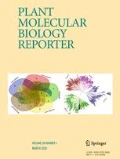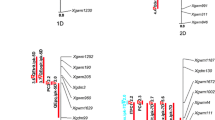Abstract
At an early stage of crop development, the rate of growth is largely determined by leaf characteristics. Plants with rapid leaf area development could save more water for transpiration and crop growth. In our study, a recombinant inbred family was used to identify quantitative trait loci (QTL) controlling leaf length (LL), leaf width (LW), and leaf area (LA) in wheat seedlings under well-watered (WW) and PEG-induced water-deficit (WD) conditions. A total of five QTL for LW, LL, and LA were detected, most of which were reported for the first time. A “constitutive” QTL for LW (Qheb.LW-3B), located on the long arm of chromosome 3B, was consistently detected under two water conditions, explaining 17.7 % of the phenotypic variance with a LOD value of 7.20 under WW condition and 13.3 % of the phenotypic variance with a LOD value of 4.87 under WD condition. The other four “adaptive” QTL were detected under a single water condition only. These QTL include the following: Qheb.LW-5B for LW (WW condition), Qheb.LL-3A, and Qheb.LL-5B for LL (WD condition) and Qheb.LA-3B for LA (WW condition). Four pairs of near isogenic lines (NILs) were developed to validate the effects of Qheb.LW-3B. The allele from the parent “CSCR6” increased the LW by an average of 8.2 % under WW condition and 13.8 % under WD condition, respectively. The position and effects of Qheb.LW-3B was confirmed. Qheb.LW-3B would be a valuable genetic resource to improve wheat seedling early establishment. The NILs we have generated would be useful for further characterization of Qheb.LW-3B, in studying its interaction with other traits of agronomic importance and in developing markers that can be reliably used to follow this major locus.

Similar content being viewed by others
References
Blum A (1996) Crop responses to drought and the interpretation of adaptation. Plant Growth Regul 20:135–148
Boote KJ, Jones JW, Pickering NB (1996) Potential uses and limitations of crop models. Agron J 88:704–716
Botwright TL, Condon AG, Rebetzke GL, Richards RA (2002) Field evaluation of early vigour for genetic improvement of grain yield in wheat. Crop Pasture Sci 53:1137–1145
Botwright TL, Rebetzke GJ, Condon AG, Richards RA (2005) Influence of the gibberellin-insensitive Rht8 dwarfing gene on leaf epidermal cell dimensions and early vigour in wheat (Triticum aestivum L.). Ann Bot 95:631–639
Cane MA, Maccaferri M, Nazemi G, Salvi S, Francia R, Colalongo C, Tuberosa R (2014) Association mapping for root architectural traits in durum wheat seedlings as related to agronomic performance. Mol Breed 34:1629–1645
Choulet F, Alberti A, Theil S, Glover N, Barbe V, Daron J, Feuillet C (2014) Structural and functional partitioning of bread wheat chromosome 3B. Science 345:1249721
Coleman RK, Gill GS, Rebetzke GJ (2001) Identification of quantitative trait loci for traits conferring weed competitiveness in wheat (Triticum aestivum L.). Crop Pasture Sci 52:1235–1246
Collins NC, Tardieu F, Tuberosa R (2008) Quantitative trait loci and crop performance under abiotic stress: where do we stand? Plant Physiol 147:469–486
Dingkuhn M, Johnson DE, Sow A, Audebert AY (1999) Relationship between upland rice canopy characteristics and weed competitiveness. Field Crops Res 61:71–95
El SM, Malosetti M, Zwaan BJ, Koornneef M, Aarts MG (2014) Genotype × environment interaction QTL mapping in plants: lessons from Arabidopsis. Trends Plant Sci 19:390–398
Goudriaan J, Van LHH (1994) Modelling potential crop growth processes: textbook with exercises (Vol. 2). Springer Science & Business Media
Hao ZF, Li XH, Liu XL, Xie CX, Li MS, Zhang DG, Zhang SH (2010) Meta-analysis of constitutive and adaptive QTL for drought tolerance in maize. Euphytica 174:165–177
Huel DG, Hucl P (1996) Genotypic variation for competitive ability in spring wheat. Plant Breed 115:325–329
Landjeva S, Neumann K, Lohwasser U, Borner A (2008) Molecular mapping of genomic regions associated with wheat seedling growth under osmotic stress. Biol Plant 52:259–266
Lemerle D, Verbeek B, Cousens RD, Coombes NE (1996) The potential for selecting wheat varieties strongly competitive against weeds. Weed Res 36:503–513
Liu X, Li R, Chang X, Jing R (2013) Mapping QTLs for seedling root traits in a doubled haploid wheat population under different water regimes. Euphytica 189:51–66
Loopez-Castaneda C, Richards RA, Farquhar GD (1995) Variation in early vigor between wheat and barley. Crop Sci 35:472–479
Loopez-Castaneda C, Richards RA, Farquhar GD, Williamson RE (1996) Seed and seedling characteristics contributing to variation in early vigour among temperate cereals. Crop Sci 36:1257–1266
Lopez-Castaneda C, Richards RA (1994) Variation in temperate cereals in rainfed environments III. Water use and water-use efficiency. Field Crops Res 39:85–98
Ma J, Li HB, Zhang CY, Yang XM, Liu YX, Yan GJ, Liu CJ (2010) Identification and validation of a major QTL conferring crown rot resistance in hexaploid wheat. Theor Appl Genet 120:1119–1128
Ma J, Yan GJ, Liu CJ (2012a) Development of near-isogenic lines for a major QTL on 3BL conferring Fusarium crown rot resistance in hexaploid wheat. Euphytica 183:147–152
Ma J, Zhang CY, Yan GJ, Liu CJ (2012b) Identification of QTLs conferring agronomic and quality traits in hexaploid wheat. J Integr Agric 11:1399–1408
Maccaferri M, Sanguineti MC, Natoli E, Araus-Ortega JL, Ben Salem M, Tuberosa R (2008) Quantitative trait loci for grain yield and adaptation of durum wheat (Triticum durum Desf.) across a wide range of water availability. Genetics 178:489–511
Manschadi AM, Hammer GL, Christopher JT (2008) Genotypic variation in seedling root architectural traits and implications for drought adaptation in wheat (Triticum aestivum L.). Plant Soil 303:115–129
Nyquist WE (1991) Estimation of heritability and prediction of selection response in plant populations. Crit Rev Plant Sci 10:235–322
Rebetzke GJ, Richards RA (1999) Genetic improvement of early vigour in wheat. Aust J Agric Res 53:41–50
Rebetzke GJ, Appels R, Morrison AD, Richards RA, McDonald G, Ellis MH, Spielmeyer W, Bonnett DG (2001) Quantitative trait loci on chromosome 4B for coleoptile length and early vigour in wheat (Triticum aestivum L.). Crop Pasture Sci 52:1221–1234
Rebetzke GJ, Botwright TL, Moore CS, Richards RA, Condon AG (2004) Genotypic variation in specific leaf area for genetic improvement of early vigour in wheat. Field Crop Res 88:179–189
Rebetzke GJ, Richards RA, Fettell NA, Long M, Condon AG, Forrester RI, Botwright TL (2007) Genotypic increases in coleoptile length improves stand establishment, vigour and grain yield of deep-sown wheat. Field Crop Res 100:10–23
Spielmeyer W, Hyles J, Joaquim P, Azanza F, Bonnett D, Ellis ME, Moore C, Richards RA (2007) A QTL on chromosome 6A in bread wheat (Triticum aestivum) is associated with longer coleoptiles, greater seedling vigour and final plant height. Theor Appl Genet 115:59–66
Steege MW, Ouden FM, Lambers H, Stam P, Peeters AJ (2005) Genetic and physiological architecture of early vigor in Aegilops tauschii, the D-genome donor of hexaploid wheat. A quantitative trait loci analysis. Plant Physiol 139:1078–1094
Tuinstra MR, Ejeta G, Goldsbrough PB (1997) Heterogeneous inbred family (HIF) analysis: a method for developing near-isogenic lines that differ at quantitative trait loci. Theor Appl Genet 95:1005–1011
Van Ooijen JW (2006) JointMap 4, software for the calculation of genetic linkage maps in experimental populations. Kyazma BV, Wageningen
Voorrips RE (2002) MAPCHART: software for the graphical presentation of linkage maps and QTLs. Heredity 93:77–78
Wang S, Basten CJ, Zeng ZB (2012) Windows QTL Cartogra- pher 2.5. Department of Statistics, North Carolina State University, Raleigh
Zhang L, Richards RA, Condon AG, Liu DC, Rebetzke GJ (2014) Recurrent selection for wider seedling leaves increases early biomass and leaf area in wheat (Triticum aestivum L) J Exp Bot:eru468
Zhou XG, Jing RL, Hao ZF, Chang XP, Zhang ZB (2005) Mapping QTL for seedling root traits in common wheat. J Integr Agric 38:1951–1957
Acknowledgments
The authors are grateful to Dr. Chunji Liu from CSIRO Agriculture Flagship for providing the seeds of the QTL mapping population used in this experiment and also for his valuable suggestions during the preparation of the manuscript. This research was partially funded by an Australian Research Council (ARC) grant LP120200830.
Author information
Authors and Affiliations
Corresponding authors
Ethics declarations
Conflict of Interest
The authors declare that they have no competing interests.
Ethics Approval
This article does not contain any studies with human participants performed by any of the authors.
Additional information
Jun Ma and Guangyue Du contributed equally to this work.
Rights and permissions
About this article
Cite this article
Ma, J., Du, G., Li, X. et al. A QTL on Chromosome 3B in Bread Wheat (Triticum aestivum) Is Associated with Leaf Width Under Well-Watered and Water-Deficit Conditions. Plant Mol Biol Rep 34, 690–697 (2016). https://doi.org/10.1007/s11105-015-0952-0
Published:
Issue Date:
DOI: https://doi.org/10.1007/s11105-015-0952-0




